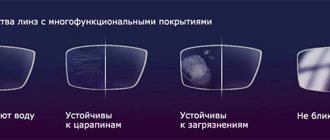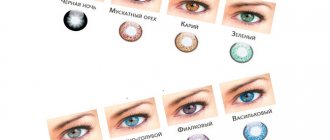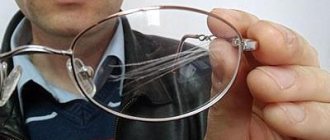When selecting lenses for glasses, it is necessary to take into account many factors that are required for the correct correction of refractive error. Deviations from the norm are determined by an ophthalmologist after diagnostic procedures. After receiving your prescription, you should carefully familiarize yourself with the optical properties of the lenses and the types of their coatings in order to avoid discomfort after purchasing glasses.
Share
Tweet
Share
Cool
Send
Where to start choosing
In order to accurately determine which lenses are needed, you need to answer a number of questions:
- how often do you need to wear glasses?
- for what purposes are they needed: driving, reading, working on a computer;
- what is the weather like at your place of residence: temperature, humidity;
- what type of frame is needed;
- whether you plan to wear glasses at home, or only during working hours.
IMPORTANT. It is necessary to obtain a prescription for the manufacture of future glasses. It should be remembered that without it it will be difficult to choose a suitable frame for the lenses. In some cases, they do not combine: for example, thin or incomplete frames are not suitable for thick glasses.
In addition, you should understand the parameters of lenses and their types.
| Parameter | Kinds | |
| Actions | Stigmatic | |
| Astigmatic | ||
| Prismatic | ||
| Main focus position | Collecting | |
| Scattering | ||
| Biconcave | ||
| Number of optical zones | Afocal | |
| Monofocal | ||
| Polyfocal | ||
| Material of manufacture | Plastic | |
| Glass | ||
| Polycarbonate | ||
| Trivex | ||
| Refractive index | Standard | |
| Sophisticated | ||
| High index lenses | ||
| Region of refractive surfaces | Spherical | |
| Aspherical | ||
| Lenticular | ||
Optical performance
Stigmatic lenses are used to correct myopia and hypermetropia. To correct vision, their shape must be biconvex. Astigmatic glasses have asymmetrical sides: one half is a hemisphere, the other is toric.
For strabismus, prismatic lenses are used, which can shift the image in the fundus. Due to their structure, different types of glass differ in their ability to refract light rays.
Based on optical power, the following types of lenses are distinguished:
- Collectors. Used to correct farsightedness. The glass is thin at the edges. The center of the lens is made of thick glass.
- Biconcave. When the beam passes through both surfaces of the lens, it is scattered.
- Scattering. Used to treat myopia. The glass in the center is thinner than at the periphery. Thanks to this, the rays can be focused evenly over the entire surface of the retina.
Refractive index
The refractive index (RI) is the most significant criterion, depending on which the thickness and volume of the lens is determined. With a high IP, the weight and thickness of the glass will be less than with low values.
The first is used in the following cases:
- with large refraction of the lens;
- for vision correction in children;
- in rimless frames.
At the same time, lenses with high PI have a weak ability to transmit light. But this disadvantage is compensated by applying an additional coating to the glass, which eliminates glare and brightens the lens. Despite the high cost, they will help ensure comfortable wearing of glasses.
The refractive index directly depends on the lens material.
| Material of manufacture | IP |
| Glass or mineral | 1,5 |
| 1,6 | |
| 1,7 | |
| 1,8 | |
| 1,9 | |
| Polymer (organic) | 1,49 |
| 1,53 | |
| 1,56 | |
| 1,59 | |
| 1,61 | |
| 1,67 | |
| 1,74 | |
| Polycarbonate | 1,59 |
| Trivex | 1,53 |
Design
Depending on the design, there are 4 main types of lenses%
- stigmatic;
- astigmatic;
- bifocal;
- progressive.
Spherical (stigmatic)
Spherical glasses are indicated for farsightedness and myopia. Because of their corresponding shape, stigmatic lenses are called spherical lenses. The main advantage of this type of glass is its high reflective ability.
Aspherical (astigmatic)
Unlike standard spherical lenses, astigmatic glasses have a flatter structure. Their shape allows you to maintain peripheral vision and high image clarity without applying additional anti-reflective coatings. Aspherical lenses do not distort the natural size of the eyes when talking with an interlocutor.
Bifocal
Bifocal lenses are conventionally divided into 2 main parts:
- the upper sector is intended for seeing objects located at a great distance;
- the lower sector is responsible for examining objects located at a short distance from a person.
This type of spectacle lenses is designed for people with presbyopia, or age-related farsightedness. In such a situation, it is difficult for patients to focus their gaze on close objects, and then quickly concentrate on viewing objects in the distance.
Progressive
Progressive lenses are a more advanced form of bifocal glass. In this type of lens, the optical properties change slowly, making a smooth transition:
- From the upper zone, designed for seeing distant objects.
- Through the intermediate, occupying a small area in the center of the lens.
- To the lower sector, responsible for seeing nearby objects.
Types of spectacle lenses by type of activity
Narrow specialization of work leads to eye fatigue at the end of the working day. Japanese companies have developed professional spectacle lenses to prevent your eyes from getting tired at the end of the working day.
“Office” spectacle lenses are designed for activities at close or medium distances, are effective at a distance of up to 2-3 meters, and provide high visual comfort.
Computer glasses lenses often do not correct vision; they are usually used for medical purposes. When working at a computer, we often move our eyes from the monitor to the paper or keyboard, which causes eye fatigue. Computer glasses reduce dryness and pain in the eyes, help improve performance, compensate for monitor glare, and relieve eye fatigue. They can be used outdoors.
Rating of the best manufacturers
In addition to physical characteristics, you must choose lenses from a certified and trusted manufacturer. The following brands are considered market leaders:
- Ray-ban;
- Maxima;
- Glance;
- Essilor
- Relax;
- Carl Zeiss;
- Rodenstock;
- Seiko.
These manufacturers produce high quality products, which are manufactured using the latest development technologies in the field of optics.
Essilor
The French company was founded in 1849. Under her leadership, 19 factories in different parts of the world produce spectacle lenses necessary for proper vision correction. Essilor is focused not only on product production, but also on research in the field of optics.
The company conducts monitoring and tests to improve the quality of its products in 390 laboratories. Therefore, before any product is mass produced, it will be tested by about 15,000 volunteers under the careful supervision of independent experts.
The company allocates 150 ml euros annually for research. Thanks to this approach, Essilor has developed a unique coating, Crizal Prevencia, which partially absorbs the blue spectrum. The latter negatively affects the functioning of photosensitive retinal cells.
Raу-Ban
The Italian corporation Ray-Ban is a leader in the quality of sunglasses. Vision lenses are also of high quality, but are not the main purpose of production. Glass from this brand not only actively protects the eyes from ultraviolet light, but also does not harm the retina.
The eyes get less tired at work, a person does not experience discomfort when wearing glasses and does not experience headaches. The company's most popular product is mirror-coated lenses.
The main disadvantage of Ray-Ban is the high cost of its products. But the high price pays off due to the wear resistance of the products, good sun protection, wide range and fashionable design.
Maxima
Maxima products are manufactured in the UK. The company produces not only eyeglass lenses, but also eye care products. Any product from this corporation is considered hypoallergenic. Products made from natural materials are especially popular. Unlike global market leaders Essilor and Ray-Ban, Maxima products are sold at an affordable price.
Types of spectacle lenses by option
Photochromic spectacle lenses are transparent indoors, but they automatically darken outdoors, and the degree of shading depends on the light intensity. Photochromic lenses improve the contrast of the visible image outdoors, ensuring only the right amount of light reaches your eyes.
Polycarbonate (impact-resistant) lenses are designed for those who lead an active lifestyle. Polycarbonate lenses are 20% thinner and 30% lighter, and are 12 times stronger than standard polymer lenses. They are completely transparent and, regardless of whether they are colored or not, provide the eyes with 100% protection from harmful radiation.
Polarized glasses lenses are designed to protect the eyes from blinding glare that occurs when light is reflected from snow or the surface of water or roads. When wearing such lenses, objects have clear contours, visual comfort increases, and image contrast increases.
Medical colored (sun-protective) lenses absorb a significant portion of solar radiation. Protects eyes from damage to the cornea, lens and retina. The degree of ultraviolet absorption is up to 400 nm.
Tips for choosing glasses
Before purchasing glasses, you must adhere to the following recommendations:
- Visit an ophthalmologist. If after a visit to the doctor it turns out that you need to purchase low-refraction lenses, you can buy frames made of metal or plastic. Such glasses are thin and light in weight. Therefore, even the purchase of rimless products is allowed.
- It is important that the frame does not cause discomfort. Uncomfortable, hard temples of glasses can pinch blood vessels, rub the thin skin above the ear and often cause irritation of the skin.
- You should not focus on fashion when choosing thick frames. This design is quite heavy, so your ears will get tired faster while wearing glasses. The person will experience discomfort and pain. In addition, horn frames are designed for thick lenses, which will only add extra weight to the glasses.
- Progressive and bifocal lenses can be worn in narrow frames. It improved the quality of vision in myopia.
- It is recommended to select a plastic frame for high-refraction lenses to compensate for the heavy weight of the glass.
- Photochromic windows are not suitable for drivers, because they darken only when exposed to direct sunlight. They will not save your eyes from bright light reflected from the road or signs. People with cars are advised to purchase darkened lenses.
- If there is a large difference in dioptres when changing glasses, the person will experience discomfort and dizziness. The discomfort will go away on its own in 3-4 days.
IMPORTANT. If you have decided to buy thick frames, it is recommended to choose products with wide temples. They partially compensate for the discomfort.
Do I need to go to the doctor?
You do not need to make an appointment with an ophthalmologist to receive a prescription. Opticians check your eyesight for free. Experts determine the necessary vision correction and give recommendations on the choice of lenses and frames for glasses.
The exclusion group includes children under 16 years of age. During this period, the visual organs continue to form. In addition, prolonged exposure to textbooks or a monitor can cause an accommodation spasm - overstraining the muscles responsible for focusing the image. In this situation, glasses are not required.
When corrected with lenses, a spasm of accommodation can provoke the development of myopia. A pediatric ophthalmologist can accurately diagnose the pathology. The doctor conducts a step-by-step study, constantly changing the prescription depending on the dynamics of the treatment of the pathology.
How to understand that glass is not suitable for you?
If the wrong lenses are fitted, a person may experience:
- dizziness;
- acute headaches when wearing glasses for a long time;
- discomfort in the eyes;
- there is a feeling of compression of the organs of vision;
- loss of orientation in space;
- sense of anxiety;
- pain in the eyes;
- deterioration of visual acuity.
You need to tell your ophthalmologist or specialist at an optical salon about your feelings.
Useful video
Some information about spectacle lens coatings: what, how, why:











